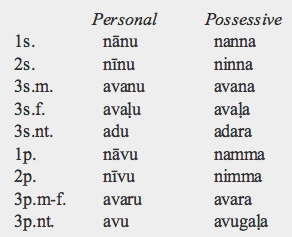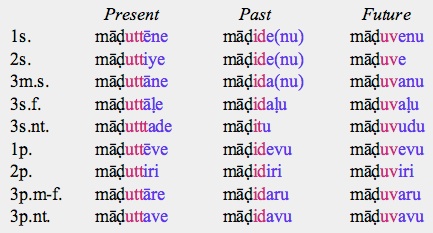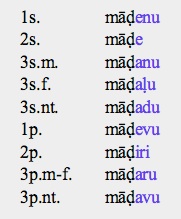An insatiable appetite for ancient and modern tongues


Alternative Names: Kanarese, Canarese.
Classification. Dravidian, Southern Dravidian. Other major South Dravidian languages are Tamil and Malayalam.
Overview. With more than forty million speakers, Kannada is an important regional language of South India and the third largest of the Dravidian family, after Tamil and Telugu. Kannada, which has its own script and an outstanding literature, is agglutinative, adding suffixes to nominal and verbal stems to indicate grammatical categories like case, number, person and tense. Less conservative than Tamil, its sound system and lexicon have been deeply influenced by the Indo-Aryan languages of north and central India.
Distribution. Kannada is spoken in the state of Karnataka in South India, and also in the neighboring states of Tamil Nadu, Andhra Pradesh and Maharashtra.
Speakers. Kannada is the mother tongue of 44 million people who live mostly in these four states of South India (speakers in millions): Karnataka (40.4), Maharashtra (1.4), Tamil Nadu (1.2), Andhra Pradesh (0.7).
Status. Kannada is the official language of the state of Karnataka and one of the 23 scheduled languages of India.
Varieties. Kannada is a diglossic language. It has caste varieties with differences in lexicon, phonology, morphology and syntax. Besides, there are three major regional dialects:
a) Mysore/Bangalore Kannada on which the standard language is based. In this variety, Sanskrit-derived words that retain their aspirated consonants and consonant clusters are frequently found.
b) Dharwad Kannada, a northern dialect spoken in the twin cities of Dharwad-Hubli.
-
c) Mangalore Kannada, a coastal dialect prevalent in the city of Mangalore and surrounding areas.
Periods
-
600-1200 Old Kannada
1200-1800 Middle Kannada
-
1800- Modern Kannada
Phonology
Vowels (10). Kannada has five short and five long vowels. All Kannada words end in a vowel.

It also has two diphthongs: ai, au.
Consonants (33-35). Besides a Dravidian consonantal inventory, Kannada has aspirated stops and supplementary sibilants borrowed from Indo-Aryan. Aspirated consonants are usually absent in pure Kannada words. In addition, it has borrowed [f] from Urdu which itself borrowed it from Arabic; it is used mainly in loanwords.

Stress. All words are accented on the first syllable.
Script and Orthography
Kannada is written in an abugida script derived from Brāhmī in which every consonant carries an inherent a. It is very similar to the Telugu script. The signs for initial vowels (shown here) are different from those for internal vowels (not shown). The alphabetic order is based on phonological principles: it starts with simple vowels and diphthongs followed by 25 stops and nasals arranged in five groups according to their place of articulation, it continues with semivowels (liquids and glides) and fricatives to end in a retroflex liquid that doesn't exist in Sanskrit and, thus, was not represented in Brāhmī.
Below each Kannada sign appears the standard transliteration in the Latin alphabet, and between square brackets its equivalent in the International Phonetic Alphabet.

-
•ṛ is a syllabic vowel found only in Sanskrit loanwords.
-
•[f] is found mostly in Urdu and English loanwords and doesn't have a specific sign, it is represented with ph that also serves for [pʰ].
Morphology
Kannada has a regular nominal and verbal agglutinative morphology of the suffixing type.
-
Nominal. Nouns are marked for case, number and sometimes gender. Attributive adjectives are invariable and precede the noun. There is an indefinite article, but not a definite one.
-
•gender: masculine, feminine, neuter. Masculine and feminine genders are reserved for 'rational' beings and neuter for 'irrational' ones. Typically, nouns ending in -anu are masculine and those ending in -aḷu, -i, -e are feminine. However, masculine markers are often omitted and not all feminine nouns are marked:
-
huḍuga(nu) (‘boy’) → huḍugi (‘girl’)
-
maga(nu) (‘son’) → maga(ḷu) (‘daughter’)
-
sevaka(nu) (male ‘servant’) → sevaki (female ‘servant’)
-
•number: singular, plural. The latter is marked by the suffixes: -(a)ru, -(a)ndru, -gaḷu. Neuter nouns are only optionally marked for plural. The marker -aru is sometimes honorific rather than plural (dēvru = god).
-
•case: nominative, accusative, instrumental, dative, genitive, locative, vocative.

-
The nominative is unmarked, the other six cases are marked by suffixes. For instance, see the declension of sēvakanu (male ‘servant’). In the singular, the vowel of the masculine marker -nu is elided as all declensional suffixes begin with a vowel. In the plural, something similar occurs with the plural marker -ru that replaces the masculine marker.
-
black: stem; brown: masculine marker
-
blue: plural marker; red: case marker.
-
•pronouns: personal, possessive, demonstrative, interrogative, reflexive, relative.

-
Personal pronouns: those for the 3rd person are identical to the remote demonstrative pronouns ('that') and distinguish gender and number. In the singular they have different masculine, feminine and neuter forms; in the plural they have just two forms, one common for masculine and feminine and the other neuter. Pronouns are declined like nouns by adding case suffixes. Possessive pronouns are personal pronouns inflected in the genitive; they can be used as adjectives or pronouns. In the latter case they must be suffixed with a personal pronoun: e.g., nannadu (‘mine’).
-
Demonstrative pronouns recognize proximate (‘this’) and remote (‘that’) locations and distinguish gender and number. The proximate demonstrative pronouns are formed by replacing the initial a of 3rd person pronouns by i: ivanu (‘this’, masc.), ivaḷu (‘this’, fem), idu (‘this’, neuter), ivaru (‘these’, masc-fem), ivu (‘these’, neuter). The remote demonstrative pronouns are identical to the 3rd person pronouns.
-
There are general and selective interrogative pronouns. The general interrogative pronouns are employed when the gender and number of the intended referent are not specified: yāru (for humans = who?), ēnu (for non-humans = what?). The selective interrogative pronouns focus on a specific member of a group and, thus, distinguish gender and number: yāvanu (masc. sg. = which man?), yāvaḷu (fem. sg. = which woman?), yāvadu (nt. sg = which thing?).
-
The reflexive pronoun is only used with 3rd person human antecedents. It has singular (tānu = oneself) and plural forms (tāvu = themselves), and may be inflected in several cases.
-
Verbal. Verbs indicate tense, aspect, mood, number, person and gender. Finite verbs have the structure: stem + tense marker + personal endings.
-
•person and number: 1s, 2s, 3s.m, 3s.f, 3s.nt; 1p, 2p, 3p (masc./fem.), 3p.nt.
-
•tense: present, past, future. The colloquial language has only past and non-past tenses.

-
The marker of the past is -id-, and the marker of the non-past is -(u)tt-.
-
The non-past expresses an habitual or future meaning.
-
The literary language has a future form, marked by -uv-, not used in the spoken language. The conjugation of māḍu ('to do', 'to make') in Literary Kannada is:
-
black: root; red: tense marker; blue: personal endings

-
Present, past and future share the same negative conjugation; the personal endings are added directly to the root:
-
•mood: indicative, imperative, optative, hortative.
-
There are several types of imperative in order to express different degrees of politeness. The optative and hortative are related to the imperative and like it they don't have tense markers. Below, we show different forms of the imperative of the verb hōg ('to go') expressing increasing degrees of politeness.

-
The first one is a familiar imperative that distinguishes gender, used with friends or children; otherwise it is insulting. Hōgu is the standard non-polite imperative; it has the plural form hōgi that has a dual role because it can also be employed as a polite imperative. Hōgri is a polite form that can be made even more polite by adding the reflexive pronoun tāvu.
-
The optative has only a 3rd person form obtained by suffixing -ali to the stem. In affirmative sentences is equivalent to 'let him' (do something) and in questions to 'should?' or 'may?'. The hortative is formed by adding -ōṇa to the verb stem and is translated as 'let's do something' in affirmative sentences or 'shall we do something?' in interrogative ones.
-
•non-finite forms: infinitives, present gerund, past gerund, negative gerund, present participle, past participle, negative participle, verbal noun.
-
There are two infinitives in Kannada, an older form in which the suffix -a(l) is added to the stem, and a historically more recent one with the suffix -okke. The latter is used, mainly, to express purpose. The present gerund is followed by a finite verb or verb phrase and indicates that the action of the gerund and that of the main verb are simultaneous. The past gerund is followed by a finite verb or verb phrase and indicates that the action of the gerund preceded that of the main verb. The negative gerund is common to the past and present gerunds, thus it is not marked for tense. The present participle serves to form adjectives from verbs; in fact most adjectives in Kannada are participles. The past participle serves to make relative clauses. The negative participle does not mark tense, so -illada can be suffixed to it to make a past negative participle. Verbal nouns can be formed by suffixing demonstrative pronouns (especially the 3rd neuter singular adu) to the present participle. The non-finite forms of māḍu are:
-
infinitive: māḍa (to do)
-
present gerund: māḍtā (doing)
-
past gerund: māḍi (having done)
-
negative gerund: māḍade (not doing, not having done)
-
present participle: māḍō (done)
-
past participle: māḍida (that was done, which was done)
-
negative participle: māḍada (not done, that was not done)
-
verbal noun: māḍōdu (the act of doing)
Syntax
Kannada word order is a quite flexible Subject-Object-Verb. Syntactic functions are conveyed by case suffixes and postpositions. It also relies heavily on participles, gerunds, and infinitives.
Nouns, participles, and pronouns governed by postpositions, usually, are in the genitive case. It is a pro-drop language i.e., the subject can be omitted since the verb itself marks person and number. It is head-final, i.e., modifiers like adjectives, adverbs and subordinate clauses precede their heads. However, auxiliaries follow main verbs. Nominal and verbal compounding is commonplace.
Lexicon
Kannada has many loanwords from Sanskrit, Prakrit, Perso-Arabic, New Indo-Aryan, and more recently, from English. From Sanskrit it has borrowed also its derivational morphology.
Basic Vocabulary. Numbers one to five differentiate gender.
one: ondu (n), obba (m/f).
two: eraḍu (n), ibbaru (m/f)
three: mūru (n), mūvaru (m/f)
four: nāku (n), nālvaru (m/f),
five: aydu (n), aivaru (m/f)
six: āru
seven: ēḷu
eight: eṇṭu
nine: omb(h)attu
ten: hattu
hundred: nūru
father: appa
mother: amma
elder brother: aṇṇa
younger brother: tamma
elder sister: akka
younger sister: tangi
son/daughter: maga
head: tale
eye: kaṇṇu
hand: kai
foot: aḍi, keḷabhāga
heart: hṛdaya (from Sanskrit)
tongue: nālage, nālige
Key Literary Works (forthcoming).
-
© 2013 Alejandro Gutman and Beatriz Avanzati
Further Reading
-
-A Kanarese Grammar. H. Spencer. Wesley Press (1950).
-
-A Reference Grammar of Spoken Kannada. H. F. Schiffman. University of Washington Press (1983).
-
-Kannada. S. N. Sridhar. Routledge (1989).
Kannada

Address comments and questions to: gutman37@yahoo.com
MAIN LANGUAGE FAMILIES
LANGUAGE AREAS
Languages of Ethiopia & Eritrea
LANGUAGES by COUNTRY
LANGUAGE MAPS
-
• America
-
• Asia
-
Countries & Regions
-
-
Families
-
• Europe
-
• Oceania